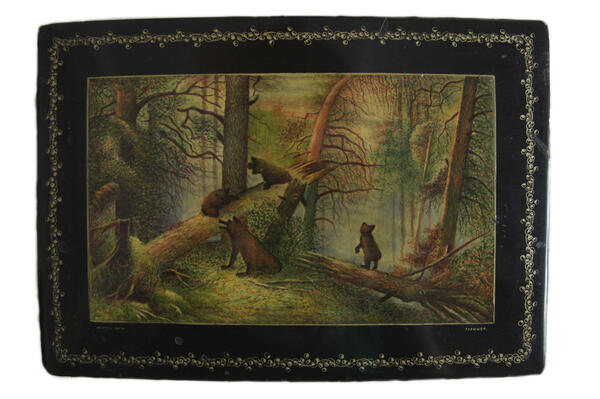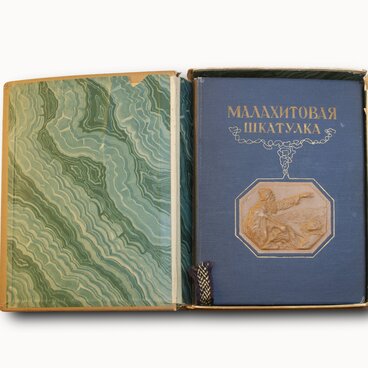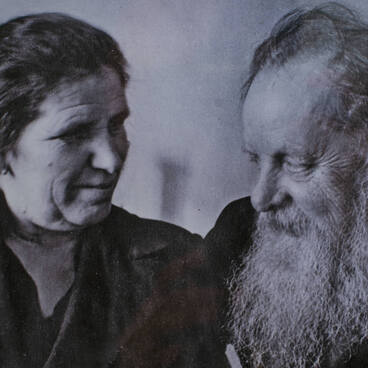Pavel Petrovich Bazhov used the displayed wooden box featuring a Mstyora miniature painting as a snuffbox. The lid depicts the famous painting by Ivan Shishkin “The Morning in a Pine Forest” reproduced by the artist Golyshev in 1948.
Mstyora miniature is a Russian folk handicraft, named after the village in Vladimir Oblast. Initially, Mstyora was famous for icon-painting: the village was considered one of the largest icon-painting centers in Russia. By the beginning of the 20th century, and especially after 1917, icon production was stopped. Thus, in continuing the old traditions, Mstyora artists began to decorate boxes with lacquer miniatures.
In the early years of the Soviet Union, artists who formed artels, which were customary at that time, painted literally on everything: on small wooden items, matryoshkas, metal trays, as did the artists in the Urals in Nizhny Tagil or in Zhostovo; they painted kitchen utensils, cigarette holders and even canvases. After the First All-Russian Agricultural and Industrial Crafts Exhibition in 1923, where Mstyora artists saw for the first time the works of the famous Palekh artists, they finally chose the style and materials that have since become traditional: they painted with tempera on papier-mâché and then lacquered the entire item.
In the middle of the 20th century, there were two trends in Mstyora miniature: the first sought to master the methods and traits of Realism, the second was traditional and offered conventional images, redolent of icon painting. The painting was made on the bleached surface and only on the lid of the box, unlike the Palekh one. A quirky gold frame on a black background, bordering the entire main image, was an obligatory element, and on the inside the boxes were painted red.
Theme-wise, Mstyora paintings included genre scenes and historical subjects, more often group portraits. Animals and architectural monuments, like fortresses and palaces, were also a popular motif. As in many other crafts, Russian folklore played a special role in Mstyora art. After Bazhov’s death, the Mstyora artists began to paint boxes inspired by the motifs from his tales “Stone Flower” and “The Mistress of the Copper Mountain”.
Mstyora miniature is a Russian folk handicraft, named after the village in Vladimir Oblast. Initially, Mstyora was famous for icon-painting: the village was considered one of the largest icon-painting centers in Russia. By the beginning of the 20th century, and especially after 1917, icon production was stopped. Thus, in continuing the old traditions, Mstyora artists began to decorate boxes with lacquer miniatures.
In the early years of the Soviet Union, artists who formed artels, which were customary at that time, painted literally on everything: on small wooden items, matryoshkas, metal trays, as did the artists in the Urals in Nizhny Tagil or in Zhostovo; they painted kitchen utensils, cigarette holders and even canvases. After the First All-Russian Agricultural and Industrial Crafts Exhibition in 1923, where Mstyora artists saw for the first time the works of the famous Palekh artists, they finally chose the style and materials that have since become traditional: they painted with tempera on papier-mâché and then lacquered the entire item.
In the middle of the 20th century, there were two trends in Mstyora miniature: the first sought to master the methods and traits of Realism, the second was traditional and offered conventional images, redolent of icon painting. The painting was made on the bleached surface and only on the lid of the box, unlike the Palekh one. A quirky gold frame on a black background, bordering the entire main image, was an obligatory element, and on the inside the boxes were painted red.
Theme-wise, Mstyora paintings included genre scenes and historical subjects, more often group portraits. Animals and architectural monuments, like fortresses and palaces, were also a popular motif. As in many other crafts, Russian folklore played a special role in Mstyora art. After Bazhov’s death, the Mstyora artists began to paint boxes inspired by the motifs from his tales “Stone Flower” and “The Mistress of the Copper Mountain”.




